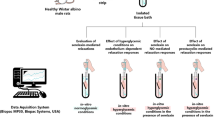Abstract
We have examined the effects of the selective 5-HT1a and 5-HT1b agonists 8-hydroxy-2-(di-n-propylamino)tetralin (8-OHDPAT) and 7-trifluoromethyl-4-(4-methyl-1-piperazinyl)-pyrrolo[1,2-a]quinoxaline (CGS12066b), respectively on erection in rats in vivo and rabbit corpus cavernosum in vitro. Apomorphine (0.1 mg/kg) induced 3.1±0.4 erections in vehicle-pretreated animals. At the highest doses tested 8-OHDPAT (0.4–0.64 mg/kg) and CGS12066b (1.0–10.0 mg/kg) significantly reduced apomorphine erection to 0.9±0.3 erections and 0.5±0.2 erections respectively. The nonselective 5-HT agonist metachlorophenylpiperazine (m-CPP; 0.1 mg/kg) elicited characteristic increases in cavernous nerve activity (CNA) and intracavernous pressure responses (ICP) in anesthetized rats. 8-OHDPAT (0.64 mg/kg) and CGS12066b (1.0 mg/kg) failed to elicit CNA or ICP responses. CGS12066b reduced ICP responses resulting from the direct stimulation of the cavernous nerve whereas 8-OHDPAT did not. CGS12066b reduced the CNA and ICP responses to m-CPP administration whereas 8-OHDPAT potentiated m-CPP induced CNA and ICP responses. In isolated rabbit corpus cavernosum (CC) 8-OHDPAT and CGS12066b both failed to alter noradrenergic induced contraction and non-adrenergic non-cholinergic relaxation. Our results indicate that selective 5-HT1a and 5-HT1b agonists have different effects in different models of erection.
This is a preview of subscription content, access via your institution
Access options
Subscribe to this journal
Receive 8 print issues and online access
$259.00 per year
only $32.38 per issue
Buy this article
- Purchase on Springer Link
- Instant access to full article PDF
Prices may be subject to local taxes which are calculated during checkout





Similar content being viewed by others
References
Meyerson BJ, Malmnas CO . Brain monoamines and sexual behavior In Hutchinson JB, ed. Biological determinants of sexual behavior. Wiley: London 1978 521–554
Ahlenius SM, Heimann M, Larrson K . Mating behavior in the male rat treated with p-chlorophenylalanine methylester alone and in combination with pargyline Psychopharmacology 1971 20: 383–388
McIntosh TK, Barfield RJ . Brain monoaminergic control of male reproductive behavior. I. Serotonin and the post ejaculatory period Brain Behav Res 1984 12: 255–265
Whalen RE, Luttge WG . p-Chlorophenylalanine methylester: an aphrodisiac? Science 1970 169: 1000–1001
Svensson L, Hansen S . Spinal monoaminergic modulation of masculine copulatory behavior in the rat Brain Res 1984 302: 315–321
Steers WD, De roat WC . Effects of m-chlorophenylpiperazine on penile and bladder function in rats Am J Physiol 1989 26: R1441–R1449
Andersson KE . Pharmacology of penile erection Pharmacol Rev 2001 53: 417–450
Berendsen HHG, Broekkamp CLE . Involvement of 5-HT1c-receptors in drug-induced penile erections in rats Psychopharmacology 1990 101: 57–61
Protais P, Windsor M, Mocaer E, Comoy E . Post-synaptic 5-HT1a receptor involvement in yawning and penile erections induced by apomorphine, physostigmine and m-CPP in rats Psychopharmacology 1995 120: 376–383
Maeda N, Matsuoka N, Yamaguchi I . Role of dopaminergic, serotonergic and cholinergic link in the expression of penile erections in rats Jpn J Pharmacol 1994 66: 59–66
Finberg JPM, Vardi Y . Inhibitory effect of 5-hydroxytryptamine on penile erectile function in the rat Br J Pharmacol 1990 101: 698–702
Millan MJ, Peglion JL, Lavielle G, Perrin-Monneyron S . 5-HT2C receptors mediate penile erections in rats: actions of novel and selective agonists and antagonists Eur J Pharmacol 1997 325: 9–12
Johansson CE, Meyerson BJ, Hacksil U . The novel 5HT1a receptor antagonist (s)-UH-301 antagonizes 8-OHDPAT induced effects on male as well as female rat copulatory behavior Eur J Pharmacol 1991 202: 81–87
Ahlenius S, Larsson K . Failure to antagonize the 8-hydroxy-2-(di-n-propylamino)tetralin-induced facilitation of male rat sexual behavior by the administration of 5-HT receptor antagonists Eur J Pharmacol 1984 99: 279–286
Berendsen HHG, Broekkamp CLE . Drug-induced penile erections in rats: indications of serotonin1b receptor mediation Eur J Pharmacol 1987 135: 279–287
Mainland D, Herrera L, Sutcliffe MI . Statistical tables for use with binomial samples-contingency tests, confidence limits and sample size estimates New York, USA: Dept. Medical Statistics Publishers 1956 New York University College of Medicine
Heaton JPW, Varrin SJ, Morales A . The characterization of a bio-assay of erectile function in a rat model J Urol 1991 145: 1099–1102
Sachs BD, Akasofu K, McEldowney SS . Effects of copulation on apomorphine-induced erection in rats Pharmacol Biochem Behav 1994 48: 423–428
Heaton JPW . Central neuropharmacological agents and mechanisms in erectile dysfunction: the role of dopamine Neurosci Biobehav Rev 2000 24: 561–569
Nissbrandt H, Water N, Hjorth S . The influence of serotoninergic drugs on dopaminergic neurotransmission in rat substantia nigra, striatum and limbic forebrain in vivo Naunyn-Schmied Arch Pharmacol 1992 346: 12–19
Foreman MM, Fuller RW, Rasmussen K et al. Pharmacological characterization of LY293284: a 5-HT1a receptor agonist with high potency and selectivity J Pharmacol Exp Ther 1994 270: 1270–1281
Ahlenius S, Larsson K . Antagonism by lisuride and 8-OH-DPAT of 5-HTP-induced prolongation of the performance of male rat sexual behavior Eur J Pharmacol 1985 110: 379–381
Hoyer D et al. VII. International union of pharmacology classification of receptors for 5-hydroxytryptamine (serotonin) Pharmacol Rev 1994 46: 157–203
Dourish CT . Multiple serotonin receptors: opportunities for new treatments for obesity? Obes Res 1995 3: (Suppl 4) 449S–462S
de Almeida RM, Nikulina EM, Faccidomo S, Fish EW, Miczek KA . Zolmitriptan—a 5-HT1B/D agonist, alcohol, and aggression in mice Psychopharmacology 2001 157: 131–141
Cheeta S et al. Anxiolytic actions of the substance P (NK1) receptor antagonist L-760735 and the 5-HT1A agonist 8-OH-DPAT in the social interaction test in gerbils Brain Res 2001 915: 170–175
Acknowledgements
The authors wish to thank the National University of Singapore for financial support of this research. LC Lau and B Srilatha are thanked for review of the manuscript.
Author information
Authors and Affiliations
Corresponding author
Rights and permissions
About this article
Cite this article
Hayes, E., Adaikan, P. The effects of 5HT1 agonists on erection in rats in vivo and rabbit corpus cavernosum in vitro. Int J Impot Res 14, 205–212 (2002). https://doi.org/10.1038/sj.ijir.3900848
Received:
Accepted:
Published:
Issue Date:
DOI: https://doi.org/10.1038/sj.ijir.3900848
Keywords
This article is cited by
-
Investigation of serotonin receptors in the isolated penile bulb of rats
International Journal of Impotence Research (2006)
-
Ultrastructural comparison of penile cavernous tissue between hypertensive and normotensive rats
International Journal of Impotence Research (2005)



